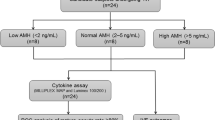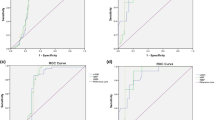Abstract
Background: Granulosa-cells are able to produce and store leptin, suggesting that this hormone is locally involved in the regulation of follicular growth. In this study, the role of follicular fluid (FF) leptin concentration in predicting oocyte fertilization and embryo quality was evaluated in 35 normogonadotrophic women undergoing controlled ovarian stimulation (COS) for assisted reproductive techniques. Materials and Methods: Leptin concentration was measured in 47 consecutively collected FF in which a mature oocyte had been found during the ovum pick-up. Embryos deriving from fertilized oocytes were submitted to quality scoring systems. Results: Mean leptin concentration was significantly higher in FF whose oocytes showed 2 pronuclei (no. 25) when compared with those with no evidence of fertilization (no. 22) at the 16–18 h check (26.0±6.1 vs 15.3±10.6 ng/ml, respectively, p<0.01). Follicular mean diameters were similar in the two groups (21.4±3.4 and 21.0±5.1 mm, respectively). Logistic regression analysis identified FF leptin levels as the best predictive parameter for oocyte fertilization (p<0.001). When receiving operating characteristics curve was employed, a FF leptin concentration of 20.25 ng/ml was the most reliable cut-off in predicting fertilization of oocytes. FF with leptin concentrations higher than this value (no. 27) had an oocyte fertilization rate of 85.7%. In contrast, FF levels ≤20.25 ng/ml (no. 20) were associated with a rate of 16.7% (p<0.05). No correlation emerged between FF leptin and the score attributed to 15 valuable embryos at the zygote stage (r=−0.01) and at 48 h after insemination (r=0.1). Conclusions: FF leptin levels are a better predictor of oocyte fertilization success rates than follicular diameter. These results underline the relevance of FF variables in developing methods for oocyte selection.
Similar content being viewed by others
References
Erickson GF, Shimasaki S. The physiology of folliculogenesis: the role of novel growth factors. Fertli Steril 2001, 76: 943–9.
Mendoza C, Ruiz-Requena E, Ortega E, et al. Follicular fluid markers of oocyte developmental potential. Hum Reprod 2002, 17: 1017–22.
Zachow RJ, Magoffin DA. Direct intra-ovarian effects of leptin: Impairment of the synergistic action of insulin-like growth factor-I on follicle-stimulating hormone-dependent estradiol-17 beta production by rat ovarian granulosa cells. Endocrinology 1997, 138: 847–50.
Finn PD, Cunningham MJ, Pau KY, Spies HG, Clifton DK, Steiner RA. The stimulatory effect of leptin on the neuroendocrine reproductive axis of the monkey. Endocrinology 1998, 139: 4652–62.
Matarese G, La Cava A. The intricate interface between immune system and metabolism. Trends Immunol 2004, 25: 193–200.
Friedman JM. The function of leptin in nutrition, weight, and physiology. Nutr Rev 2002, 60: S1–14.
Farooqi IS, Matarese G, Lord GM, et al. Beneficial effects of leptin on obesity, T cell hyporesponsiveness, andneuroendocrine/metabolic dysfunction of human congenital leptin deficiency. J Clin Invest 2002, 110: 1093–103.
Chan JL, Heist K, De Paoli A, Veldhuis J, Mantzoros C. The role of falling leptin levels in the neuroendocrine and metabolic adaptation to short-term starvation in healthy men. J Clin Invest 2003, 111: 1409–21.
Welt C, Chan JL, Bullen J, et al. Recombinant human leptin in women with hypothalamic amenorrhea. N Engl J Med 2004, 351: 987–97.
Foster DL, Nagatani S. Physiological perspectives on leptin as a regulator of reproduction: role in timing puberty. Biol Reprod 1999, 60: 205–15.
Conway GS, Jacobs HS. Leptin: a hormone of reproduction. Hum Reprod 1997, 12: 633–5.
Zamorano PL, Maehsh VB, de Sevilla LM, Chorich LP, Bhat GK, Brann DW. Expression and localization of the leptin receptor in endocrine and neuroendocrine tissues of the rat. Neuroendocrinology 1997, 65: 223–8.
Cioffi JA, Shafer A, Zupancic T, et al. Snodgrass HR. Novel B219/ob receptor isoforms: possible role of leptin in hematopiesis and reproduction. Nat Med 1996, 2: 585–8.
Antczak M, Van Blerkom JV. Oocyte influences on early development: the regulatory proteins leptin and STAT3 are polarizated in mouse and human oocytes and differentially distribuited within the cells of the preimplantations stage embryo. Mol Hum Reprod 1997, 3: 1067–86.
Barroso G, Barrionuevo M, Rao P, et al. Vascular endothelial growth factor, nitric oxide, and leptin follicular fluid levels correlate negatively with embryo quality in IVF patients. Fertil Steril 1999, 72: 1024–6.
Bützow TL, Moilanen JM, Lehtovirta M, et al. Serum and follicularfluid leptin during in vitro fertilization: relationship among leptin increase, body fat mass, and reduced ovarian response. J Clin Endocrinol Metab 1999, 84: 3135–9.
Messinis IE, Milingos S, Zikopoulos K, Kollios G, Seferiadis K, Lolis D. Leptin concentrations in the follicular phase of spontaneous cycles and cycles superovulated with follicle stimulating hormone. Hum Reprod 13: 1152–6.
Messinis IE, Milingos SD. Leptin in human reproduction. Hum Reprod 1999, 5: 52–63.
Mantzoros CS, Cramer DW, Liberman RF, Barbieri RL. Predictive value of serum and follicular fluid leptin concentrations during assisted reproductive cycles in normal women and in women with the polycystic ovarian syndrome. Hum Reprod 2000, 15: 539–44.
Welt C, Schneyer A, Heist K, Mantzoros C. Leptin and soluble leptin receptor in follicular fluid. J Assist Reprod Genet 2003, 12: 495–501.
Simoni M, Bakker E, Eurlings MC, et al. Laboratory guidelines for molecular diagnosis of Y-chromosomal microdeletions. Int J Androl 1999, 22: 292–9.
De Placido G, Mollo A, Alviggi C, et al. Rescue of IVF cycles by HMG in pituitary down-regulated normogonadotrophic young women characterized by a poor initial response to recombinant FSH. Hum Reprod 16: 1875–9.
De Placido G, Wilding M, Strina I, et al. High outcome predictability after IVF using a combined score for zygote and embryo morphology and growth rate. Hum Reprod 17: 2402–9.
Nikolettos N, Asimakopoulos B, Nicolettos N, et al. Evaluation of leptin, interleukin-1beta, tumor necrosis factor-alpha and vascular endothelial growth factor in serum and follicular fluids of women undergoing controlled ovarian hyperstimulation as prognostic markers of ICSI outcome. In vivo 2004, 18: 667–73.
Asimakopoulos B, Nikolettos N, Papachristou DN, Simopoulou M, Al-Hasani S, Diedrich K. Follicular fluid levels of vascular endothelial growth factor and leptin are associated with pregnancy outcome of normal women participating in intracytoplasmic sperm injection cycles. Physiol Res 2005, 54: 263–70.
Tsai EM, Yang CH, Chen SC, et al. Leptin affects pregnancy outcome of in vitro fertilization and steroidogenesis of human granulosa cells. J Assist Reprod Genet 2002, 19: 169–76.
Sakkas D, Urner F, Bianchi PG, et al. Sperm chromatin anomalies can influence decondensation after intracytoplasmic sperm injection. Hum Reprod 1996, 11: 837–43.
Razavi S, Nasr-Esfahani MH, Mardani M, Mafi A, Moghdam A. Effect of human sperm chromatin anomalies on fertilization outcome post-ICSI. Andrologia 2003, 35: 238–43.
Caglar GS, Hammadeh M, Asimakopoulos B, Nikolettos N, Diedrich K, Al-Hassani S. In vivo and in vitro decondensation of human sperm and assisted reproduction technologies. In vivo 2005, 19: 623–30.
Fatehi AN, Bevers MM, Schoevers E, Roelen BA, Colenbrander B, Gadella BM. DNA damage in bovine sperm does not block fertilization and early embryonic development but induces apoptosis after the first cleavages. J Androl 2006, 27: 176–88.
Tesarik J, Greco E, Mendoza C. Late, but not early, paternal effect on human embryo development is related to sperm DNA fragmentation. Hum Reprod 2004, 19: 611–5.
Tesarik J. Paternal effects on cell division in the human preimplantation embryo. Reprod Biomed Online 2005, 10: 370–5.
Loffler S, Aust G, Kohler U, Spanel-Borowski K. Evidence of leptin expression in normal and polycystic human ovaries. Mol Hum Reprod 1991, 7: 1143–9.
Agarwal SK, Vogel K, Weitsman SR, Magoffin DA. Leptin antagonizes the insulin-like growth factor-I augmentation of steroidogenesis in granulosa and theca cells of the human ovary. J Clin Endocrinol Metab 1999, 84: 1072–6.
Brannian JD, Zhao Y, Mc Elroy M. Leptin inhibits gonadotropin-stimulated granulosa cell progesterone production by antagonizing insulin action. Hum Reprod 1999, 14: 1445–8.
Author information
Authors and Affiliations
Corresponding author
Rights and permissions
About this article
Cite this article
De Placido, G., Alviggi, C., Clarizia, R. et al. Intra-follicular leptin concentration as a predictive factor for in vitro oocyte fertilization in assisted reproductive techniques. J Endocrinol Invest 29, 719–726 (2006). https://doi.org/10.1007/BF03344182
Accepted:
Published:
Issue Date:
DOI: https://doi.org/10.1007/BF03344182




